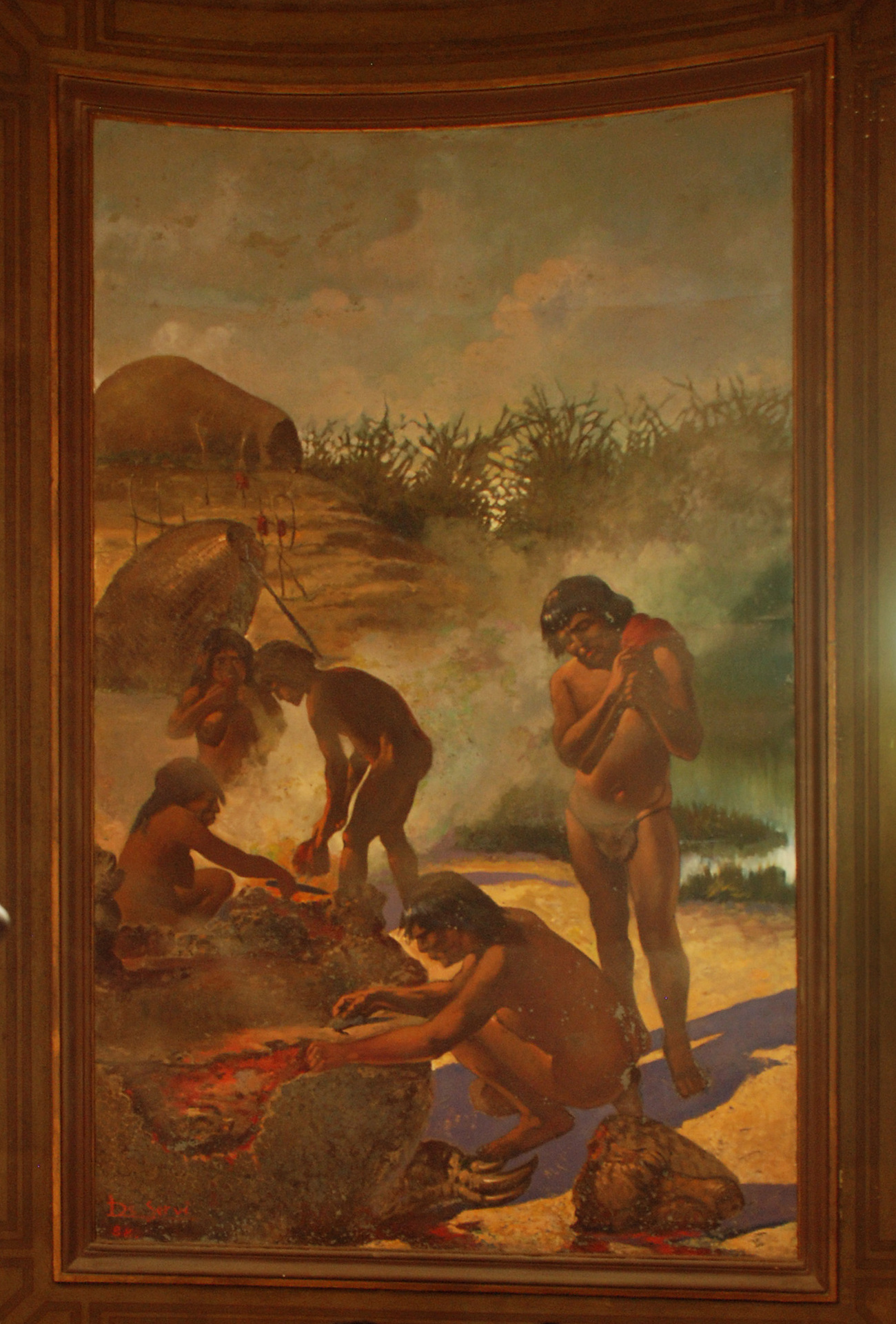Depiction of 'The Man of the Great Armadillo'
Beschreibung
The GLYPTODON is a huge four-legged mammal with an armadillo-like carapace that lived and went extinct in South America, and which had been named by the English anatomist Richard Owen in 1839. By the mid-nineteenth century, it was one of the most wanted museum specimens. Along with MEGATHERIUM, both were used to depict the life in South American tertiary. The Museo de La Plata has quite a few of these mammals on display, which are identified as being from different subspecies of the subfamily Glyptodontinae.
GLYPTODON's skeletons are an interesting case to understand the cultural elements that define the material world of Argentine museums and the material culture of elementary education. The depiction of 'The Man of the Great Armadillo' was popularized in the first decades of the twentieth century through museums and schoolbooks, and was connected with theories southern origin of humanity.
The solidity of the shell was created by museum displays and book depictions, and created a companion for the Argentines of the twentieth century, who accepted that GLYPTODON's shell was the first home of local prehistoric humans. In fact, the shell is very fragile, to mount a GLYPTODON requires expertise, a lot of work, and materials such as plaster, glue, etc.
Further Reading:
- Irina Podgorny (June 9, 2021). A train of glyptodonts, La Plata Museum, Argentina. SciCoMove — Scientific Collections on the Move. Retrieved March 21, 2025 from <https://doi.org/10.58079/twr8>.
GLYPTODON's skeletons are an interesting case to understand the cultural elements that define the material world of Argentine museums and the material culture of elementary education. The depiction of 'The Man of the Great Armadillo' was popularized in the first decades of the twentieth century through museums and schoolbooks, and was connected with theories southern origin of humanity.
The solidity of the shell was created by museum displays and book depictions, and created a companion for the Argentines of the twentieth century, who accepted that GLYPTODON's shell was the first home of local prehistoric humans. In fact, the shell is very fragile, to mount a GLYPTODON requires expertise, a lot of work, and materials such as plaster, glue, etc.
Further Reading:
- Irina Podgorny (June 9, 2021). A train of glyptodonts, La Plata Museum, Argentina. SciCoMove — Scientific Collections on the Move. Retrieved March 21, 2025 from <https://doi.org/10.58079/twr8>.
Kurzbeschreibung
The GLYPTODON is a huge four-legged mammal with an armadillo-like carapace that lived and went extinct in South America, and which had been named by the English anatomist Richard Owen in 1839. By the mid-nineteenth century, it was one of the most wanted museum specimens. Along with MEGATHERIUM, both were used to depict the life in South American tertiary. The Museo de La Plata has quite a few of these mammals on display, which are identified as being from different subspecies of the subfamily Glyptodontidae.
Institution
Typ
GLYPTODON sp.
Thema
megafauna, paleontology, history of taxonomy, 18th century, La Plata
Zeit
First decades of the 20th century
Ort
Argentina, La Plata
Material/Technik
Painting
Förderung
Project: SciCoMove - Scientific Collections on the Move: Provincial Museums, Archives and Collecting Practices (1800-1950).
Funding: This project has received funding from the European Union’s Horizon 2020 research and innovation programme under the Marie Skłodowska-Curie grant agreement No 101007579.
The contents of this publication are the sole responsibility of the SciCoMove consortium and do not necessarily reflect the opinion of the European Union.
Funding: This project has received funding from the European Union’s Horizon 2020 research and innovation programme under the Marie Skłodowska-Curie grant agreement No 101007579.
The contents of this publication are the sole responsibility of the SciCoMove consortium and do not necessarily reflect the opinion of the European Union.
Dateien

Quellenangabe
„Depiction of 'The Man of the Great Armadillo',” SciCoMove, zuletzt aufgerufen am 1. Juli 2025, https://ausstellungen.deutsche-digitale-bibliothek.de/scicomove/items/show/42.
